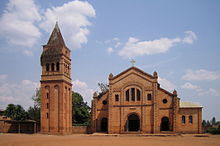Human occupation of Rwanda is thought to have begun shortly after the last ice age. By the 11th century, the inhabitants had organized into a number of kingdoms. In the 19th century, Mwami (king) Rwabugiri of the Kingdom of Rwanda conducted a decades-long process of military conquest and administrative consolidation that resulted in the kingdom coming to control most of what is now Rwanda. The colonial powers, Germany and Belgium, allied with the Rwandan court.

Juvénal Habyarimana was a Rwandan politician and military officer who served as the second president of Rwanda, from 1973 until his assassination in 1994. He was nicknamed Kinani, a Kinyarwanda word meaning "invincible".

Sectarian violence and/or sectarian strife is a form of communal violence which is inspired by sectarianism, that is, discrimination, hatred or prejudice between different sects of a particular mode of an ideology or different sects of a religion within a nation/community. Religious segregation often plays a role in sectarian violence.

The Rwandan genocide, also known as the genocide against the Tutsi, occurred between 7 April and 15 July 1994 during the Rwandan Civil War. During this period of around 100 days, members of the Tutsi minority ethnic group, as well as some moderate Hutu and Twa, were killed by armed Hutu militias. Although the Constitution of Rwanda states that more than 1 million people perished in the genocide, the actual number of fatalities is unclear, and some estimates suggest that the real number killed was likely lower. The most widely accepted scholarly estimates are around 500,000 to 800,000 Tutsi deaths.

Mutara III Rudahigwa was King (umwami) of Rwanda between 1931 and 1959. He was the first Rwandan king to be baptised, and Roman Catholicism took hold in Rwanda during his reign. His Christian names were Charles Léon Pierre, and he is sometimes referred to as Charles Mutara III Rudahigwa.
Elizaphan Ntakirutimana was a Rwandan pastor of the Seventh-day Adventist Church. He was the first clergyman to be convicted for a specific leadership role in the 1994 Rwandan genocide.
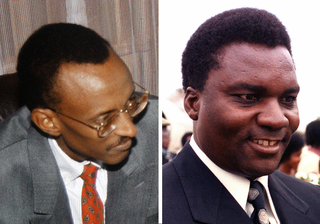
The Rwandan Civil War was a large-scale civil war in Rwanda which was fought between the Rwandan Armed Forces, representing the country's government, and the rebel Rwandan Patriotic Front (RPF) from 1 October 1990 to 18 July 1994. The war arose from the long-running dispute between the Hutu and Tutsi groups within the Rwandan population. A 1959–1962 revolution had replaced the Tutsi monarchy with a Hutu-led republic, forcing more than 336,000 Tutsi to seek refuge in neighbouring countries. A group of these refugees in Uganda founded the RPF which, under the leadership of Fred Rwigyema and Paul Kagame, became a battle-ready army by the late 1980s.

The Murambi Technical School, now known as the Murambi Genocide Memorial Centre, is situated near the town of Murambi in southern Rwanda.
Athanase Seromba is a Catholic priest from Rwanda who was found guilty of committing genocide and of crimes against humanity during the Rwandan genocide.

Islam is the largest minority religion in Rwanda, practiced by 2% of the total population according to the 2012 census. Virtually all Muslims in Rwanda are Sunni Muslim. Islam was first introduced into Rwanda by Muslim traders from the East Coast of Africa in the 20th century. Since its introduction, Muslims have been a minority in the territory, while Christianity, was introduced to Rwandans during the colonial period in the beginning of the 20th century, and is now the largest religion in the country.
Vincent Nsengiyumva was a Rwandan prelate of the Roman Catholic Church who served as Archbishop of Kigali from 1976 until his death.

Father Wenceslas Munyeshyaka is a Rwandan priest working in France who was convicted of genocide by a Rwandan military court. Munyeshyaka was pursued in the French courts but in October 2015 the case was not continued because of the quality of the evidence. Despite the controversy and his Rwandan conviction he has been employed as a priest in France since 2001.
Emmanuel Rukundo is a Rwandan Roman Catholic priest who in 2009 was convicted of genocide and crimes against humanity by the International Criminal Tribunal for Rwanda (ICTR) for his participation in the 1994 Rwandan Genocide.
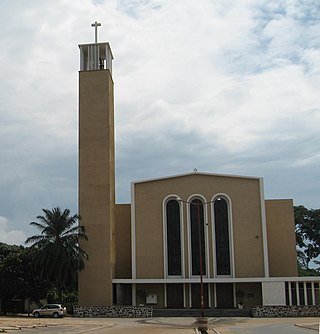
Religion in Burundi is diverse, with Christianity being the dominant faith. Catholicism is the largest Christian denomination in the country.

The Rwandan Revolution, also known as the Hutu Revolution, Social Revolution, or Wind of Destruction, was a period of ethnic violence in Rwanda from 1959 to 1961 between the Hutu and the Tutsi, two of the three ethnic groups in Rwanda. The revolution saw the country transition from a Tutsi monarchy under Belgian colonial authority to an independent Hutu-dominated republic.

Sainte-Famille Church is a Catholic church in Muhima, downtown Kigali, in Rwanda. It is located on a hill, close to the cell of Rugenge. Sainte-Famille Church was the scene of killings during the genocide in April 1994.
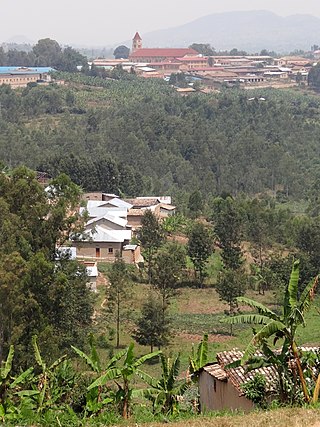
Kabgayi is just south of Gitarama in Muhanga District, Southern Province, Rwanda, 25 miles (40 km) southwest of Kigali. It was established as a Catholic Church mission in 1905. It became the center for the Roman Catholic Church in Rwanda and is the site of the oldest cathedral in the country and of Catholic seminaries, schools and a hospital. The church at first supported the Tutsi ruling elite, but later backed the Hutu majority. During the 1994 Rwandan genocide thousands of Tutsis who had taken refuge here were killed. Some survivors admire the courage of many priests who helped them during those difficult days, like Father Evergiste RUKEBESHA and many others. Later, some Hutus including three bishops and many priests were killed by the rebels RPF soldiers. A mass grave beside the hospital is marked by a memorial. Inside the Basilica are kept the bodies of the three bishops killed by FPR rebels. Two of them were refused by the Rwandan government to be transferred in their own cathedrals.
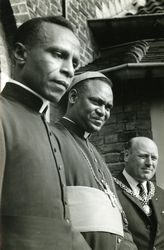
Wenceslas Kalibushi was a Rwandan Catholic bishop.
The following lists events that happened during 1994 in the Republic of Rwanda.

The Catholic Church in colonial Rwanda had significant influence over the country as a result of the church's involvement in most aspects of the country's infrastructure. The Catholic missionaries, also known as the White Fathers, arrived at the same time as the first German colonial empire administrators, so both parties were very involved in shaping the influence of colonizers on Rwanda. Throughout the colonial period, the Catholic Church expanded its influence in different industries. The resources of the church improved many Rwandans' lives. However, the church also perpetuated extreme inequality in the country through their favoritism of Tutsis over the other ethnic groups.
